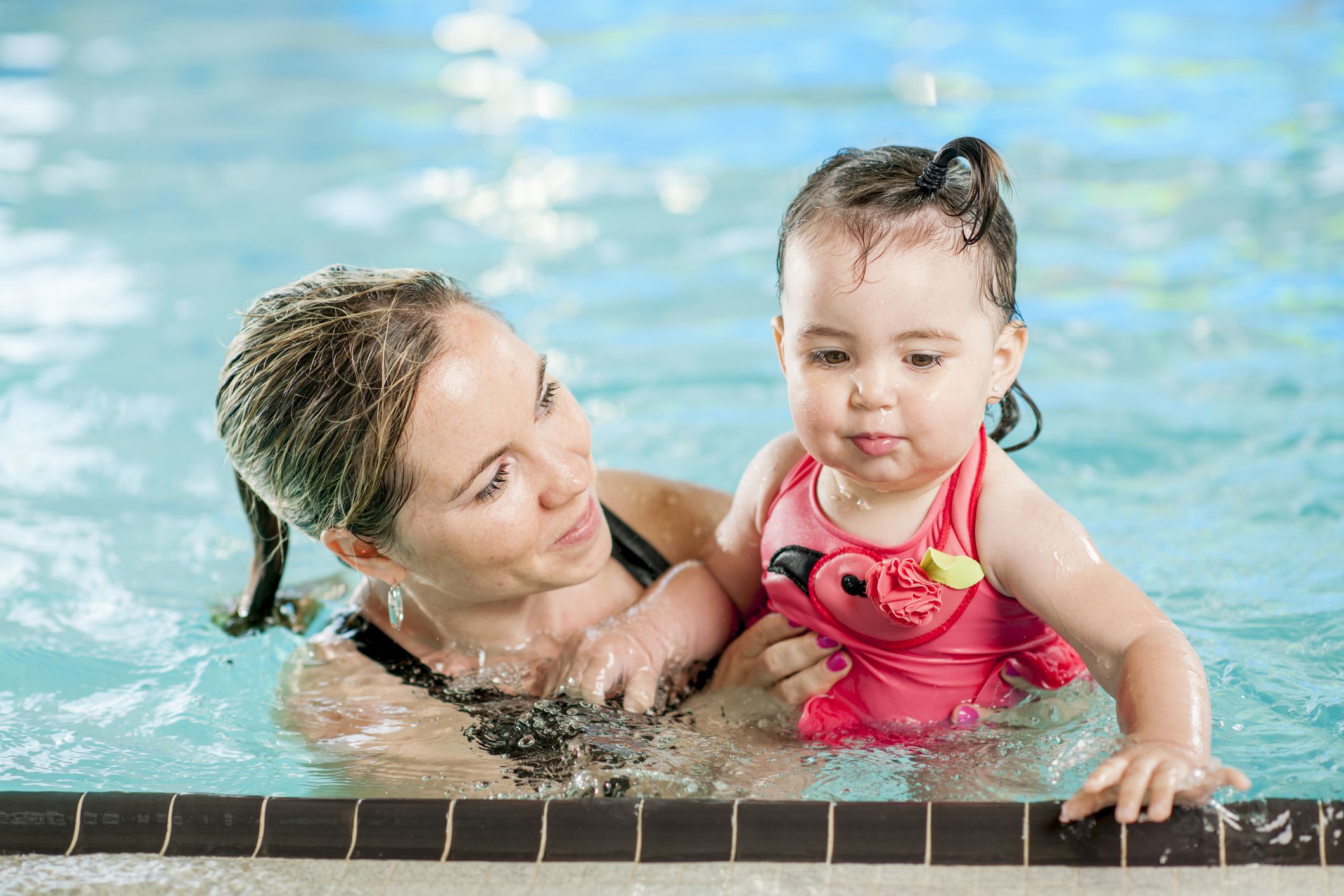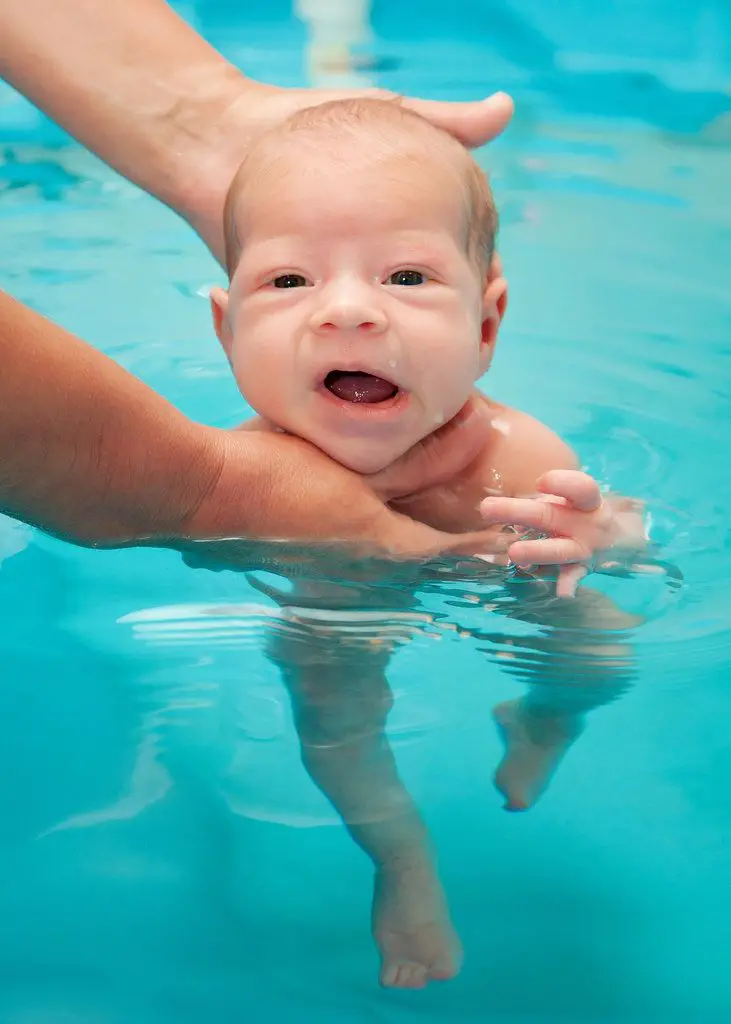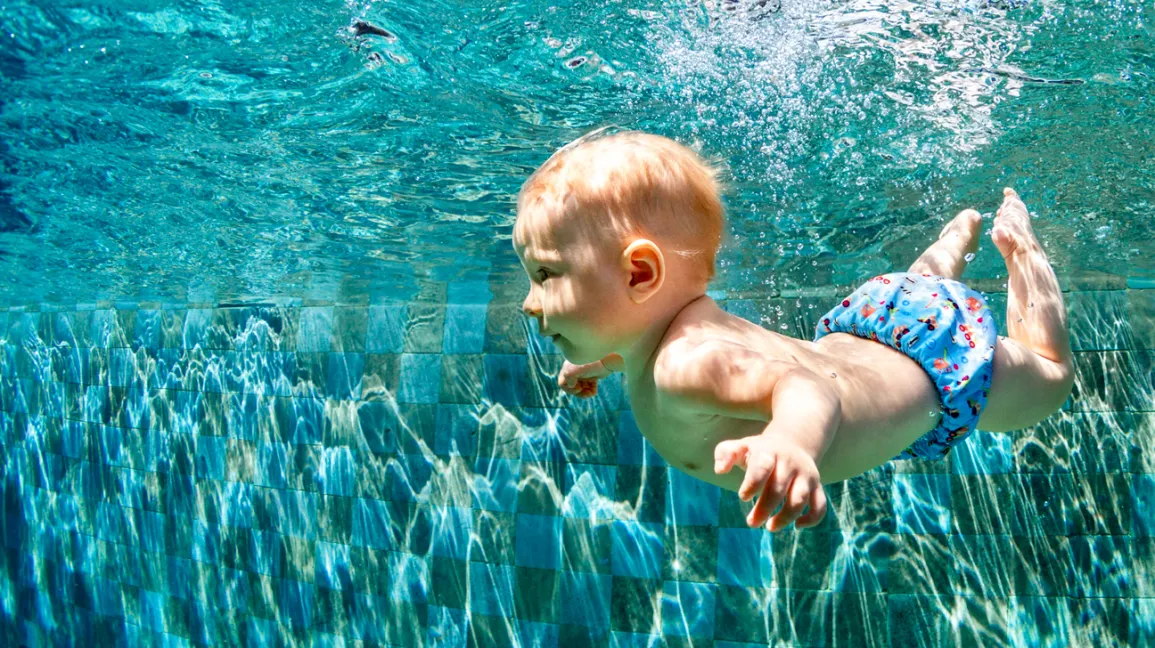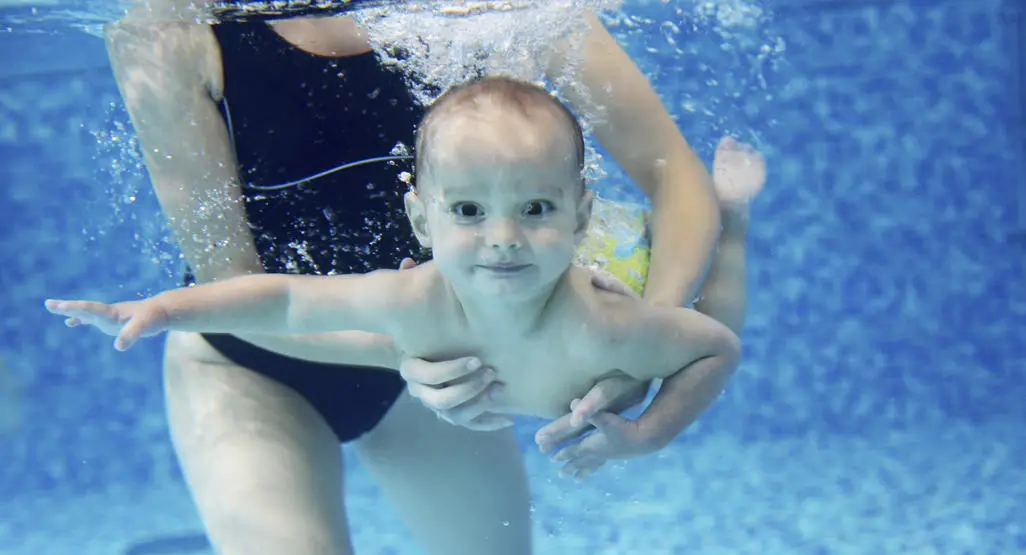Are you considering carrying your baby to the pool for the first time? According to experts, you can expose your baby to water whenever you feel relaxed or as long as their circumcision or belly button has healed. (However, always consult your pediatrician first.) The younger a child is when they begin splashing, the more at ease they are in the pool.

Swimming is a critical and life-saving skill that you can teach your babe at a young age, and there are many excellent techniques to employ when teaching your baby to swim.
So, how to teach a baby to swim? Introducing your baby to hold their breath underwater is the first big step in swimming. Then you can concentrate on self-rescue techniques such as swim-float-swim, floating, kicking, and simple strokes designed to keep your baby safe in any water depth.
Are you ready to jump in? Here’s where to begin.
The important fact to know before considering how to teach a baby to swim
Learning to swim is a compelling adventure for a child. They not only learn the fundamentals of water safety but also lay the groundwork for an active and healthy lifestyle.
The American Academy of Pediatrics (AAP) advises formal swim lessons as a layer of protection against drowning to help children develop the skills to be safe in the water.
Even though the current AAP guidelines are considered best practices, not all families can afford swim lessons. Parents and caregivers must frequently step in and independently teach their children the fundamentals.
Introduce your baby to swimming with BERGO
BERGO is just the ABCDs you must remember before taking your kid to swim. Be early, Entertain your baby, stay Relaxed, Get wet and step out when necessary. If you can incorporate these things into your child’s swimming routine, you can easily make them a pro in swimming.
Be early: The town pool is less crowded in the morning. Furthermore, your baby will (hopefully) be well rested after a good night’s sleep. The sun is also weaker before 10 a.m., lowering their risk of sunburn. But your baby still needs sunscreen!
Entertain your babe: Bring a toy or a game, such as a motorboat. Sway back and forth with the baby under their armpits, singing, “Motor boat, motor boat, go so slow.” If they agree, quicken the pace and sing, “Motor boat, motor boat, step on the gas!”
Stay Relaxed: Get set by humming the tune “Where you lead, I will follow” – cause your baby can detect your emotional state. They will try to follow your lead if you appear to be having fun, even if you are nervous. Begin slowly, dipping your child’s toes into the water to get them used to the sensation of water on their skin.
Get wet soon: If your baby appears content, drip water all over them, gradually increasing the amount. Once in the pool, stay where you can easily stand and hold on to them at all times. Even in the kiddie pool, keep an arm’s length distance.
If they appear upset, step Out: You want their first time in the pool to be pleasant. Trying to force your baby to go swimming may end up doing more harm than good in the long run. If they don’t seem ready, wait a month or so and try again.
How to teach a baby to swim: When to Begin?

Are you considering taking swimming lessons? Sign up your kid to swim after their first birthday. Most swim schools teach babies who are 6 months and up. Nevertheless, the American Academy of Pediatrics (AAP) does not recommend formal programs until 12 months. There is no proof that they are worthwhile, and the health risks of swallowing water are higher than one year.
For children over one year, the organization recommends that parents decide whether to enroll their child in swim lessons based on their child’s water exposure, emotional development, physical abilities, and certain health conditions related to pool water infections and chemicals. Evidence suggests that instruction for children over the age of one year is not only safe but may also help prevent drowning.
What are babies taught in swim lessons?
They will first become accustomed to being in the water. They’ll learn basic skills like kicking, blowing bubbles, pulling with their arms, and getting their faces wet. They’ll eventually dunk and, when they’re a little older, around 3 or 4, they’ll take off swimming!
Is it necessary for babies to wear a life jacket during swim lessons?
Connie Harvey, manager of aquatics technical development at the American Red Cross Preparedness and Health and Safety Services, advises against it during lessons. “You want them to experience what it’s like to swim without a flotation device.” Furthermore, a vest places the baby in a vertical position, which is unnatural for swimming.
What is the best type of baby swim class?
Look for classes with up to ten caregiver-baby pairs. Look for a relaxed, flexible pace in a fun environment. An organization should certify instructors on a national level.
How to teach a baby to swim: The beginnings
Set your expectations
Teaching your baby to swim is a survival skill, besides an extracurricular activity. Prepare to dedicate yourself to the learning process no matter what. Swimming requires repetition, practice, and dedication. You must be prepared to get into the water as often as possible with your child, day after day until they’ve mastered the necessary skills. The promising news is that teaching, and reinforcing swim skills only takes a few minutes each day.
First and foremost, safety
The essential rule to remember when teaching your child to swim is, of course, safety. There are important safety rules to follow, regardless of the swimmer’s ability level. Always review water safety precautions with your children. Kids respond incredibly well to pictures and photos, Collins says. Try finding a fun image to help them remember the safety rules. Consider the AAP’s pool safety guidelines to get started.
- When your child is in the pool, stay close by. If you must leave, take them with you.
- The parent or caregiver who intends to teach your child should also be able to swim and perform CPR.
- Avoid employing inflatable swimming support such as floaties when working with your child. Use a life jacket if your child requires flotation.
Address Your Child’s Concerns
- You can help a reluctant swimmer or a child afraid of water prepare for the pool without dipping their toes in the water.
- Fill a small cup with warm (but not hot) water and pour a small, steady stream of water over your child’s shoulders and head. Collins claims that this will help them adjust to the water’s temperature.
- Allow them to experiment – As your child expresses an interest in swimming, give them a pair of goggles to wear in the tub or shower. This can familiarize a child with the benefits of using goggles, which can help to create a more positive pool experience.
- Blowing bubbles and playing in the bathtub are two other great ways to teach them that water is enjoyable.
Make it enjoyable
You can play several games once they’re in the pool to get them excited about swimming.
- Blow bubbles: This may seem like a simple activity, but kids enjoy blowing bubbles, which allows them to get used to being in the water.
- Get them goggles: Goggles are an excellent way to make a kid feel more relaxed in the water because they permit swimmers to glimpse underwater clearly, which removes the fear of the unknown.
- Play some fun games with your children as they become more comfortable. You can play games like diving for rings or kicking with a red or green light.
- Train climbing in and out of the pool: Have your child practice climbing out of the pool while holding on to the side of the wall.
- Swim with a lifejacket: Swimming with a lifejacket aids in movement in the water, which Collins claims can be very beneficial in developing effective pulling and kicking motions.

Teach basics of swimming
Swimming is more important than floating for survival and self-rescue. Swimming entails lying face down in the water, holding one’s breath and keeping one’s eyes open while moving through the water with kicks and simple strokes. When your child lowers their face and opens their eyes to look at the bottom of the pool, their buttocks will rise, and they will be able to kick their legs. At that point, they’re swimming!
To help toddlers and older children learn how to swim, use the phrase “face down, butt up!” to help them remember the proper swimming position.
New swimmers who do not put their faces in the water are “doggy paddling,” not swimming. This technique is exhausting, and small children can quickly become exhausted if it is the only way they know to swim.
Hopefully, there are some straightforward steps you can take to teach basic swimming in your home pool, spa, or even bathtub:
Teach the Swim-Float-Swim technique
- Place your kid’s face in the water, close their eyes, and hold their breath. Their body will naturally come to the surface.
- While in this position, your swimmer should kick while keeping an eye on their destination.
- They can breathe by turning their heads to one side, removing their face from the water, and breathing through their mouth.
- When your swimmer begins to tire, roll onto their back and float. They have the option of resting in this position or continuing to kick.
- To keep an eye on their destination and make faster progress toward safety, your swimmer should regularly roll back to the swim position.
Assist your kid in learning how to breathe in the water
- Allow them to hold the pool’s edge while pushing their body away from it.
- Your kid should take a deep breath and immerse their face in the water.
- The kid should then practice kicking while exhaling air through their nose and mouth and keeping their face down and eyes open.
- When they need to take a breath, rotate their neck so their face is visible above the water. They can then breathe normally through their mouth. Keep reminding them to keep going!
- The kid should immediately return to a face-down position after taking a quick breath.
How to teach a baby to swim: Factors to check before taking swimming classes
Look for classes and instructors who adhere to guidelines that include swim-stroke techniques and broader water survival competency skills. All children, for example, should learn how to get back to the surface from underwater, drive themselves 25 yards, and get out of the water. Instructors should assess students’ progress and provide continuous feedback on their skill levels.
Look for swimming classes for children of all ages that:
- Have qualified and experienced instructors: A nationally recognized learn-to-swim curriculum should be used to train and certify swim instructors. Lifeguards with current CPR and First Aid certifications should also be on duty.
- Teach good water safety practices in, on, and near water: Children should never swim alone or without the supervision of an adult. Instructors should teach children to always ask their parents, lifeguards, or swimming instructors for permission before getting down to the pool or natural body of water, such as a lake.
- Instruct kids what to do if they find themselves in the water suddenly: This includes working on water competency skills like self-rescue. Lessons must include a variety of realistic scenarios, such as falling in and swimming in clothes. Older kids should also learn what to do if someone else is struggling in the water and how to get help.
- Allow you to observe a class first to determine if it is appropriate for your child: Not all swim classes are created equal, and parents must do their homework to find the best. Are they swimming majorly, or do they have long periods of inactivity while waiting for their turn? Is one-on-one attention given to children? You should check these things.
- Multiple sessions are required: Once children begin lessons, you should notice a gradual but consistent improvement in their abilities over time. Continue lessons until they have mastered basic water competency skills.
- Create an age-appropriate environment: During lessons, your child should feel safe and secure with activities that support their social, intellectual, physical, and emotional development. On the other hand, children must develop a healthy respect for water.
- Have “touch supervision”: An adult should be within arm’s reach of infants and toddlers whenever they are in or near water, even during swim lessons. Parent participation should be encouraged, especially because it informs families about what to do between classes. If you cannot join your child in the water, look for private classes that provide one-on-one instruction.
- Keep the water pure: Because young children are more likely to swallow or breathe in the water, proper water disinfection and chlorine levels are critical. A good program should also require the child to wear a swimsuit that fits snugly around the legs to prevent body waste from entering the water.
Also Read: How To Tie Shoes For Kids- Best Tips And 5 Poems To Help Kids!

How to teach a baby to swim: Tips to effectively monitor your kid while swimming
One of the effective ways to help prevent drowning is to provide proper supervision in the water, even if your child is learning to swim. Keep the following tips in mind to effectively supervise and keep your child safe during swim time:
- Pay close attention at all times. Even if lifeguards are present, do not become distracted by other activities (such as reading, playing games, using a cell phone, or mowing the lawn).
- Avoid using alcohol or drugs near water, especially if you are supervising others.
- Get in the water with younger children and weak swimmers. “Touch supervision” is required! Even if you are not swimming but are near a pool or body of water, keep children within arm’s reach at all times. Take the kid with you if you must leave.
- Do not leave a baby or young child in or near any body of water while another child is in charge.
- Assign a “water watcher” whose job is to constantly keep an eye on the child in or near the water, especially during parties or picnics at the pool or lake where it is easy to become distracted. After a certain amount of time, take turns passing a water watcher card to the next responsible adult.
Concluding thoughts
Teaching your child to swim begins with keeping them safe around water. Make sure your child understands the rules of a pool or beach, and always stay close by and keep an eye on them while they swim.
After acclimating them to the water, you can progress to basic swimming skills like kicking, arm movement, and the doggie paddle. Learning to swim is never too early or too late. Babies as young as four months old and teenagers can learn to swim. Swimming will also keep your child safer in the water.
Frequently asked questions on how to teach a baby to swim
- What is the soundest way to introduce a baby to swimming for the first time?
Once both of you are at ease, gently bounce the baby up and down in the water. Move your infant from back to front and front to back again. To begin, stick to short sessions. 10-20 minutes is plenty of time.
- Is it feasible for babies to learn to swim on their own?
Your child should be ready for independent swim lessons by three or four. They’ll learn fundamental skills like floating, treading water, and getting out of the water.
- When can babies start taking swimming lessons?
Yes, even newborns can begin learning to swim. Although it is theoretically possible to teach newborn babies to swim as soon as they are born, it is more common for baby swimming lessons to begin around 3 months or later. There’s no need to rush if you believe your baby isn’t ready.
- How do you clean your baby after swimming?
4 baby swimming skincare tips: Before going swimming, gently rinse the baby. Before swimming, apply moisturizer to your skin. After swimming, use baby shampoo to rinse. Before dressing the baby, apply lotion.
- Do babies require armbands when swimming?
Babies under a year old cannot wear armbands, but most toddlers prefer the safety and security that a buoyancy aid can provide. Furthermore, armbands do not always provide the best body alignment and limit arm movement when learning to swim.
- What temperatures are safe for babies to swim in?
If your child is under six months old, look for a heated pool to 30-32 degrees. Many swimming lessons will be held in specially heated pools. Consider purchasing a neoprene wetsuit if you intend to swim in a pool cooler than 30-32 degrees.
- Is it necessary for babies to wear swim diapers?
In most cases, babies and children under three or four must wear a swim diaper when swimming or playing in a public pool. Even if your children are potty trained, keeping them in a swim diaper is best to avoid accidents.
- How long can a kid be left in a swimming pool?
First, don’t leave your baby in the pool for more than 10 minutes. Immediately wrap your baby in a warm blanket or towel when you get out. Babies under 12 months should not be in a pool for more than 30 minutes.

